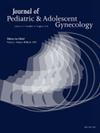6. Evaluating the diagnostic work-up of heavy menstrual bleeding and hemostatic efficacy of norethindrone acetate in improving menstrual suppression among adolescent girls with obesity
IF 1.7
4区 医学
Q3 OBSTETRICS & GYNECOLOGY
引用次数: 0
Abstract
Background
Adolescent obesity continues to rise in prevalence and is a risk factor for many etiologies of heavy menstrual bleeding (HMB), yet comprehensive guidelines on the evaluation and management of HMB in obese adolescents is lacking. This study aims to (1) characterize the prevalence of obesity and menstrual characteristics among adolescents presenting to the emergency department (ED) with HMB, (2) investigate the hemostatic efficacy of norethindrone acetate (NA) relative to IV conjugated estrogen in obese adolescents.
Methods
A retrospective chart review with collection of demographic and clinical data was performed, including all ED encounters (2017-2022, excluding 2020 due to COVID-19 pandemic) at three affiliates of a large tertiary children's hospital that utilized an acute HMB clinical pathway. Obesity was defined by BMI equal to or greater than the 85th percentile. Hemostatic efficacy was defined as follows: red blood cell (RBC) transfusion, tranexamic acid (TXA) utilization, and length of stay (LOS) >36 hours. TXA use was a surrogate for poorly controlled HMB at 24 hours; the clinical pathway recommended adding TXA if HMB persisted despite primary hemostatic agent at 24 hours. T tests and chi squared statistics were used to compare continuous and categorical variables, respectively. Multivariate logistic regression models were used to predict adjusted odds ratios of outcome variables (NA vs. IV conjugated estrogen) separately among all non-obese and obese individuals.
Results
Between 2017-2022, 402 adolescents were admitted from the ED for HMB with documented BMI measurements. Over half were obese. Obese adolescents disproportionately identified as Black and reported younger onset of menarche. When adjusting for admission hemoglobin, receiving NA alone was associated with significantly decreased odds of RBC transfusion (AOR: 0.265, 95% CI: 0.104-0.674; p=0.005) relative to receiving IV conjugated estrogen among non-obese individuals. When adjusting for platelet levels, receiving NA alone was associated with significantly decreased odds of TXA utilization (AOR: 0.107, 95% CI: 0.013-0.859; p=0.036) among non-obese individuals. However, among obese individuals, we observed no association with odds of transfusion (p=0.267), TXA utilization (p=0.265) or LOS >36 hours (p=0.472) by hemostatic agent.
Conclusions
In the setting of acute HMB, treatment with NA is associated with reduced odds of RBC transfusion and TXA utilization among non-obese but not obese individuals, highlighting the potential disparities in treatment response based on obesity status.
6. 评价青春期少女肥胖患者经期大出血的诊断及醋酸去甲thindrone改善月经抑制的止血效果
背景:青少年肥胖的患病率持续上升,并且是许多病因性月经大出血(HMB)的危险因素,但缺乏关于肥胖青少年月经大出血评估和管理的综合指南。本研究旨在(1)了解急诊科(ED)患有HMB的青少年的肥胖患病率和月经特征,(2)研究醋酸去甲thindrone (NA)相对于静脉结合雌激素在肥胖青少年中的止血效果。方法对一家大型三级儿童医院的三家附属医院采用急性HMB临床途径的所有急诊病例(2017-2022年,不包括2020年因COVID-19大流行)进行回顾性统计和临床数据回顾。肥胖的定义是BMI等于或大于第85个百分位数。止血疗效的定义如下:红细胞(RBC)输注、氨甲环酸(TXA)的使用、住院时间(LOS) 36小时。使用TXA代替24小时控制不良的HMB;如果HMB在24小时内仍然存在,临床路径建议添加TXA。分别采用T检验和卡方统计量比较连续变量和分类变量。使用多变量logistic回归模型分别预测所有非肥胖和肥胖个体的结局变量(NA vs. IV结合雌激素)的校正优势比。结果2017-2022年间,402名青少年因BMI测量记录在案的HMB从急诊科入院。超过一半的人肥胖。肥胖青少年不成比例地被认定为黑人,而且据报道初潮开始的时间更早。当调整入院血红蛋白时,单独接受NA可显著降低红细胞输血的几率(AOR: 0.265, 95% CI: 0.104-0.674;p=0.005)与非肥胖个体接受静脉结合雌激素相关。当调整血小板水平时,单独接受NA可显著降低TXA利用的几率(AOR: 0.107, 95% CI: 0.013-0.859;P =0.036)。然而,在肥胖个体中,我们观察到与输血几率(p=0.267)、TXA利用率(p=0.265)或使用止血剂后36小时的LOS (p=0.472)无关。结论:在急性HMB的情况下,NA治疗与非肥胖和非肥胖个体中红细胞输血和TXA利用的几率降低有关,突出了基于肥胖状态的治疗反应的潜在差异。
本文章由计算机程序翻译,如有差异,请以英文原文为准。
求助全文
约1分钟内获得全文
求助全文
来源期刊
CiteScore
3.90
自引率
11.10%
发文量
251
审稿时长
57 days
期刊介绍:
Journal of Pediatric and Adolescent Gynecology includes all aspects of clinical and basic science research in pediatric and adolescent gynecology. The Journal draws on expertise from a variety of disciplines including pediatrics, obstetrics and gynecology, reproduction and gynecology, reproductive and pediatric endocrinology, genetics, and molecular biology.
The Journal of Pediatric and Adolescent Gynecology features original studies, review articles, book and literature reviews, letters to the editor, and communications in brief. It is an essential resource for the libraries of OB/GYN specialists, as well as pediatricians and primary care physicians.

 求助内容:
求助内容: 应助结果提醒方式:
应助结果提醒方式:


